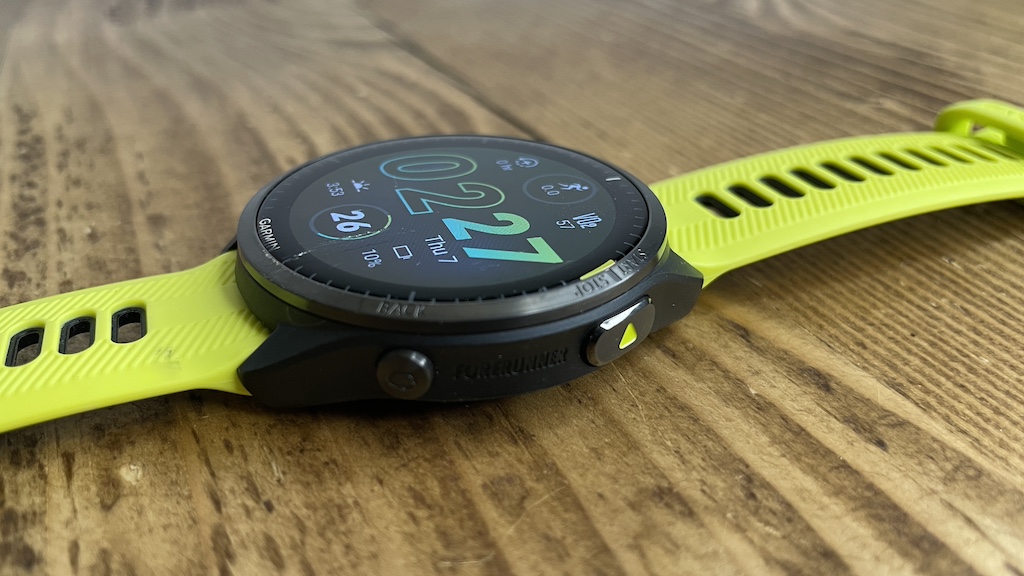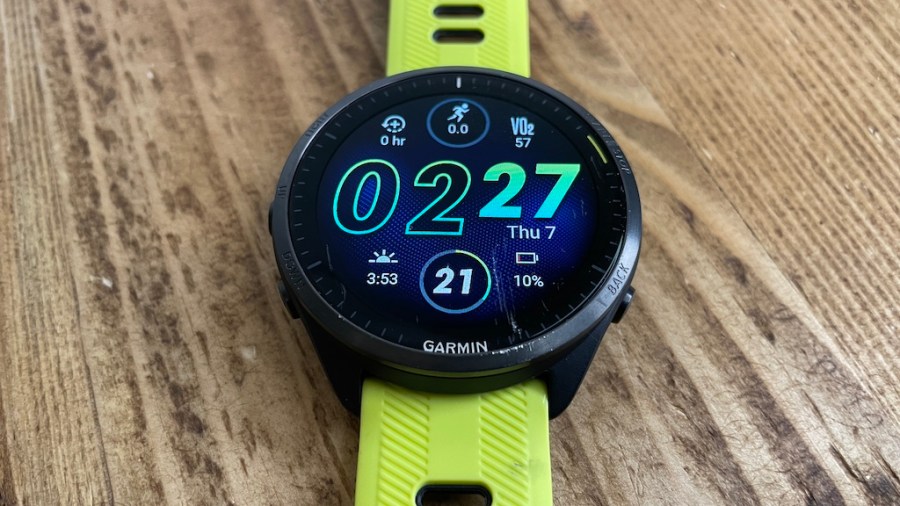The Garmin Forerunner 965 is the most comprehensive running watch on the market right now
The most recent edition of Garmin’s highest-spec running watch, the Forerunner 965, is more than £100 pricier than its predecessor, the Forerunner 955. But for that extra outlay, it now features an ultra-run-friendly 31-hour GPS battery life, a full set of Garmin’s most advanced training, fitness, health and activity tools, plus some Fenix-level mapping and navigation tools. Oh, and other smarts like offline music and Garmin Pay contactless payments help make it top of our list of best running watches.
Men’s Fitness verdict
The ultra-crisp AMOLED touchscreen adds some user-friendly smartwatch style to Garmin’s market-leading training, performance and recovery insights. Accuracy and battery life are also impressive.- Large, stunning, bright display
- Multiband GPS
- Week-long battery life
- Screen prone to scratching (as shown in image below…)
- Price hike on the Forerunner 955
- Larger screen might not suit all wrists
How we test running watches
Kieran Alger is an ultramarathon runner and professional product tester. He ran with each of these watches for a minimum of four weeks, across a range of distances near his base in West London.

AMOLED excellence and big battery life
The big upgrade – and the big selling point – here is undoubtedly the large, crisp, bright AMOLED touchscreen that adds a touch of Apple Watch vibrancy to your running and training metrics. Regular running watch screens are dull by comparison to the latest smartwatches but that’s now changing with the Forerunner joining the Garmin Epix range with its big, bright, crisp screen. Though you will sacrifice battery life for the pleasure of having your stats jump out. The cheaper Forerunner 955 has more run-time staying power, stretching to 80 hours GPS run time in low-power mode.
Fortunately, the Forerunner 965’s battery life still has plenty for most runners. On paper, it claims 23 days on standby – that’s better than the Apple Watch. You get 31 hours in regular GPS mode, dropping to 19 hours if you fire up the max accuracy All Systems + Multiband tracking. Even less if you connect your headphones and use the offline music.
In my tests it largely lived up to billing. A one-hour run using Normal GPS mode burned on average around 3%. A five-hour run in UltraTrac low power mode burned 9%, while an eight-hour ultra test, using full accuracy GPS mode burned just 13%. This watch won’t kill your battery anxiety like the Garmin Enduro 2, but overall there’s enough juice here to handle a week’s running with ease on a single charge and 100km and 100-mile ultrarunners should have plenty here, too.
Design and accuracy
Beyond the beautiful screen, this is generally a good-looking watch. The tougher, lighter titanium bezel adds a nice finish. And while it’s still a running watch by design, the Forerunner 965 now has a subtle style that’s starting to feel a bit more smartwatch. The bigger 1.4-inch touchscreen now matches the Fenix 7’s real estate but, at 52g, the Forerunner 965 is still a better option for those who prefer lighter and less hefty watches on the wrist than Garmin’s rugged adventure watch.
Speaking of ruggedness, the Forerunner 965 screen is coated in a Gorilla Glass DX outer layer to toughen it up against bumps and knocks. However, I managed to scratch mine quite easily. So it’s not totally scratch-proof. It has dual touchscreen and button controls that give you maximum control. I found both nicely responsive. Some touch screens can be laggy; this one isn’t.
GPS accuracy is boosted by multiband GPS. Meanwhile, features like new SatIQ try to squeeze as much juice out of the Forerunner 965 as possible, by automatically figuring out the optimal GPS mode to use based on your environment.
I tested the Forerunner 965 GPS and heart rate performance against the Apple Watch Ultra 2, the Garmin Enduro 2, the Polar Vantage V3 and the new Suunto Race. I found the overall distance tracking very reliable. If you dig into the GPS tracks, it’s not infallible – you’ll see the odd excursion through buildings and into rivers – but it’s up there with the best.
The optical heart rate performance was good, too. It was more reliable than the Apple Watch Ultra 2 and up against a Polar H10 chest strap, it often matched the max and averages. There was some lag to the real time changes during interval sessions and on runs and workouts with big changes in intensity, but that’s optical heart rate for you.
The navigation tools are excellent, too. In fact, the Forerunner 965 is now arguably the most affordable way to access full colour maps and the AMOLED screen really brings those to life. If you run lumpier routes and trails, ClimbPro gives you a better window into what’s up ahead with easy access to climb details, including gradient, distance, and elevation gain, before or in real time while you’re plodding a course.
The training, performance and recovery feature set is about as comprehensive as you’ll find. You get everything from training effect and VO2 Max estimates, to recovery time recommendations and Training Load monitoring. Running dynamics are now tracked from the wrist, too, so no need for an additional sensor or footpod. These include cadence, stride length, ground contact time and running power. There’s Garmin’s HRV status tool and Pulse Ox sensor to keep track of your health vitals outside of training. And Garmin’s morning report offers a quick and easy summary of where you’re at – at least as a rough guide.
One final word: if you don’t care about the AMOLED screen, go for the cheaper Garmin Forerunner 955. It has the same features, maps and a longer battery life.
Garmin Forerunner 965 technical specs
| Display | AMOLED (optional always-on mode) |
| Display resolution | 454 x 454pixels |
| Display size | 35.4mm (diameter) |
| Connectivity | Bluetooth, ANT+, WiFi |
| Weight | 52g |
Related content:







